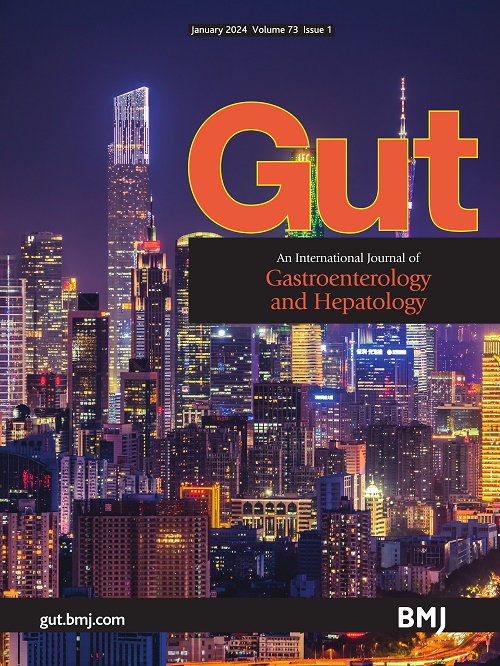Galectin-4 drives anti-PD-L1/BVZ resistance by regulating metabolic adaptation and tumour-associated neutrophils in hepatocellular carcinoma.
IF 25.8
1区 医学
Q1 GASTROENTEROLOGY & HEPATOLOGY
引用次数: 0
Abstract
BACKGROUND The combination of atezolizumab and bevacizumab (ATZ/BVZ) therapy has significantly advanced therapeutic approaches for hepatocellular carcinoma (HCC). However, less than 30% of patients achieve durable responses, highlighting the urgent need to understand mechanisms underlying resistance. OBJECTIVE This study aimed to elucidate the mechanisms of resistance to ATZ/BVZ therapy in HCC and identify druggable targets associated with resistance, thus improving the treatment efficacy of ATZ/BVZ-resistant HCC. DESIGN We employed single-cell RNA sequencing and a prospective clinical cohort (NCT04649489) to identify and characterise potential genes that contribute to ATZ/BVZ therapy resistance. Multiple preclinical HCC models and a coculture system were constructed, and cytometry by time-of-flight technology was used to further explore the relevant molecular mechanism. RESULTS Elevated baseline serum galectin-4 levels correlated with resistance to ATZ/BVZ therapy and unfavourable prognosis in HCC. Galectin-4 overexpression nullified ATZ/BVZ therapy efficacy through promoting metabolic adaptation and fostering an immunosuppressive tumour microenvironment characterised by reduced infiltration and impaired cytotoxicity of CD8+ T cells and accumulation of PD-L1+ tumour-associated neutrophils. Mechanistically, galectin-4 inhibited proteasomal degradation of lactate dehydrogenase A (LDHA) by competitively decreasing tripartite motif containing 28 binding, thereby enhancing glycolysis and amplifying HIF-1α-mediated C-X-C motif chemokine ligand 6 (CXCL6) expression. Genetic knockdown or pharmacological inhibition of galectin-4 reversed metabolic adaptation and immune exclusion, and restored sensitivity to anti-PD-L1/BVZ therapy in preclinical models. CONCLUSION Activation of the galectin-4/LDHA/HIF-1α and CXCL6 axis plays a pivotal role in ATZ/BVZ therapy resistance. Galectin-4 serves as a promising therapeutic target to improve immunotherapy efficacy and an effective predictive biomarker for immunotherapy response in HCC.半乳糖凝集素-4通过调节肝细胞癌的代谢适应和肿瘤相关中性粒细胞来驱动抗pd - l1 /BVZ耐药。
背景:阿特唑单抗和贝伐单抗(ATZ/BVZ)联合治疗显著推进了肝细胞癌(HCC)的治疗方法。然而,只有不到30%的患者获得持久的反应,这突出表明迫切需要了解耐药性的潜在机制。目的阐明肝癌对ATZ/BVZ治疗的耐药机制,寻找与耐药相关的可药物靶点,提高ATZ/BVZ耐药HCC的治疗效果。我们采用单细胞RNA测序和前瞻性临床队列(NCT04649489)来鉴定和表征导致ATZ/BVZ治疗耐药的潜在基因。构建多个临床前HCC模型和共培养体系,利用飞行时间技术进行细胞计数,进一步探讨相关分子机制。结果基线血清半乳糖凝集素-4水平升高与HCC患者对ATZ/BVZ治疗的耐药性和不良预后相关。半乳糖凝集素-4过表达通过促进代谢适应和培养以CD8+ T细胞浸润减少和细胞毒性受损以及PD-L1+肿瘤相关中性粒细胞积累为特征的免疫抑制肿瘤微环境,使ATZ/BVZ治疗效果无效。在机制上,半乳糖凝集素-4通过竞争性地降低含有28结合的三方基序来抑制乳酸脱氢酶A (LDHA)的蛋白酶体降解,从而增强糖酵解并扩增hif -1α-介导的C-X-C基序趋化因子配体6 (CXCL6)的表达。在临床前模型中,基因敲低或药理抑制半乳糖凝集素-4可逆转代谢适应和免疫排斥,并恢复对抗pd - l1 /BVZ治疗的敏感性。结论半凝集素-4/LDHA/HIF-1α和CXCL6轴的激活在ATZ/BVZ治疗耐药中起关键作用。半乳糖凝集素-4是一种很有前景的治疗靶点,可以提高HCC的免疫治疗疗效,也是一种有效的预测免疫治疗反应的生物标志物。
本文章由计算机程序翻译,如有差异,请以英文原文为准。
求助全文
约1分钟内获得全文
求助全文
来源期刊

Gut
医学-胃肠肝病学
CiteScore
45.70
自引率
2.40%
发文量
284
审稿时长
1.5 months
期刊介绍:
Gut is a renowned international journal specializing in gastroenterology and hepatology, known for its high-quality clinical research covering the alimentary tract, liver, biliary tree, and pancreas. It offers authoritative and current coverage across all aspects of gastroenterology and hepatology, featuring articles on emerging disease mechanisms and innovative diagnostic and therapeutic approaches authored by leading experts.
As the flagship journal of BMJ's gastroenterology portfolio, Gut is accompanied by two companion journals: Frontline Gastroenterology, focusing on education and practice-oriented papers, and BMJ Open Gastroenterology for open access original research.
 求助内容:
求助内容: 应助结果提醒方式:
应助结果提醒方式:


